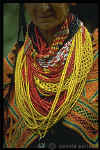|
|
||||
| Home
JUNE 2001- Contents Culture Sports Health Lifestyle Visual Arts People Travel & Adventure
|
|
|
||
|
the-south-asian.com June 2001 |
||||
|
Page 4 of 6
The Kalasha of Pakistan (cntd) Problems of Minority Development and Environmental Management By Peter Parkes
Indigenous Knowledge Despite their cultural distinction as a non-Muslim minority, Kalasha subsistence is comparable with that of the majority of other (Muslim) peoples of northern Pakistan, who all practise a classic 'mixed mountain economy' of small-scale agriculture combined with transhumance livestock husbandry. Grain crops, together with fruit and walnut trees, are cultivated on tiny irrigated and terraced fields at an altitude around 1800 metres; while herds of goats are taken to high mountain pastures in summer, returning to winter stables around evergreen oak woodland above their villages. A wide range of natural resources at different altitudes is thus exploited, enabling most households - with barely a hectare of arable land and a few score goats - to be largely self-sufficient. Compared with neighbouring regions, the Kalasha valleys seem well endowed with natural resources for this agro-pastoral subsistence. Most noticeable to visitors are the thick forests of holm covering the scree slopes above Kalasha villages, which elsewhere in Chitral are denuded. These oaks provide essential winter fodder for goats, as well as firewood for households, and they are carefully harvested by pollarding. Kalasha are thereby able to maintain far larger herds of livestock than most of their Muslim neighbours, which in turn make a vital contribution to cereal production through the regular application of manure to fields. Combined with a highly labour-intensive tillage of hoeing, weeding and watering, performed by women, Kalasha crop yields are thereby many times higher than those reported of other small farmers in Chitral, despite comparable average holdings of cultivated land amounting to just over half a hectare. The valleys are also well furnished with arable terraces and alluvial fans occuring at altitudes below 2000 metres, where double-cropping is feasible, within easy access of irrigation channels fed by gravity-flow from the rivers. At higher altitudes, from around 2,300 metres, occur dense forests of pines and Himalyan cedar, comprising perhaps half of the total conifer forests remaining in Chitral. Beyond these forests are alpine pastures of rough grasses and sedges, which provide easily sufficient browzing for Kalasha goats. Despite frequent reports of their destitution, Kalasha subsistence thus appears both more productive than that of many of their neighbours, and also associated with an unusually richly resourced natural environment. The isolation of the valleys prior to road building in the 1970s, combined with meagre population growth until then, has evidently facilitated a subsistence economy placing low demands on natural resource consumption. Yet this has also been a product of intentional collective management, organized through 'traditional' institutions. Most prominent is the annual appointment of a 'constabulary' of youths, the roi, responsible for coordinating ritual offerings and subsistence activities throughout the year. Among their duties are the supervision of household contributions to the clearing of irrigation channels in spring, the regulation of the ascent and descent of the goat herds, and the imposition of a 'closed season' on fruit and walnut harvesting in summer.
The most important transformation of Kalasha subsistence in recent decades, however, has been the sponsored construction of new irrigation channels. Channel-building is almost synonymous with a now prevalent concept of developmental 'progress'. Yet few of these channels have yet been completed, and several have encountered problems of construction. Despite programmatic intentions to employ 'culturally relevant skills and institutions', all of these channels have been built according to an outside engineer's survey and use roughly dressed stones set in poor cement rather than the traditional dry-stone walling constructed by gradual trial-flow, for which Kalasha were once renowned artisans. As Saifullah Jan, a major contractor for government sponsored channel-building throughout the 1980s, ruefully explained: "We all know that the old dry-stone channels worked well; they even got stronger year by year, bound by the roots of trees and grass. But for a contractor there is no profit. So we call in the engineer, and we make it 'pukkah' with cement, even if it may collapse in a year or two. But then, there will be another contract..."
|
||||
| Copyright © 2000 [the-south-asian.com]. Intellectual Property. All rights reserved. | ||||
| Home |

